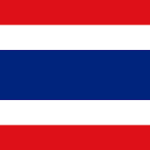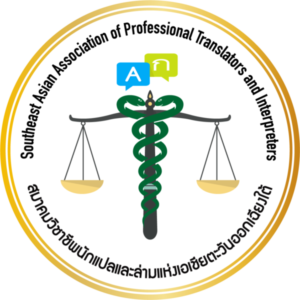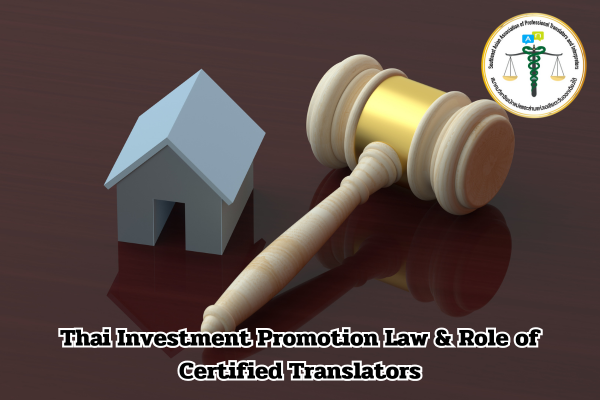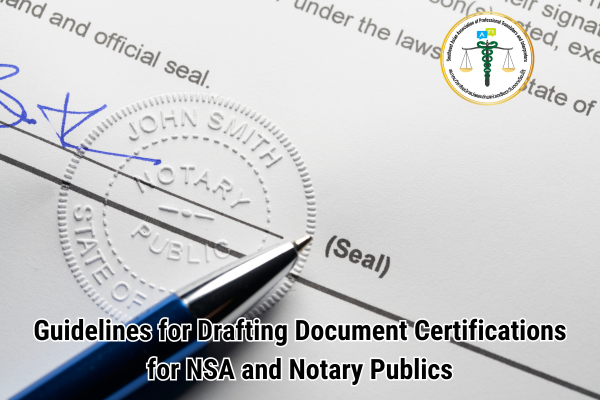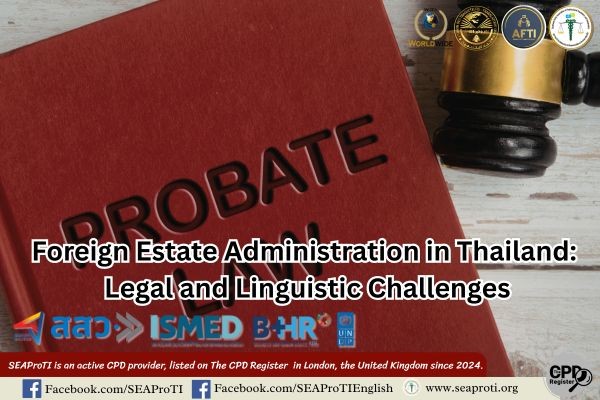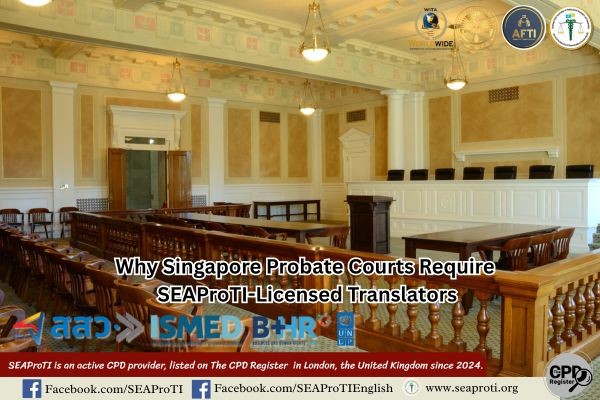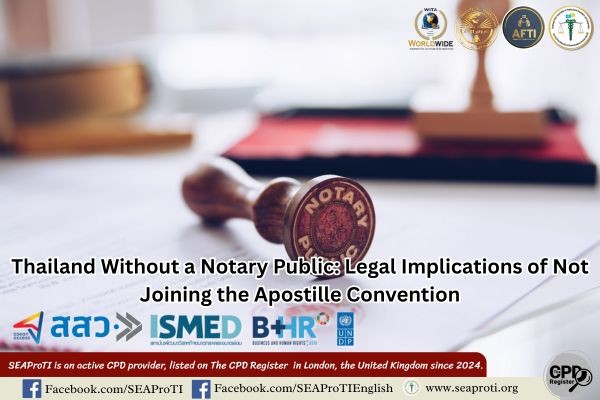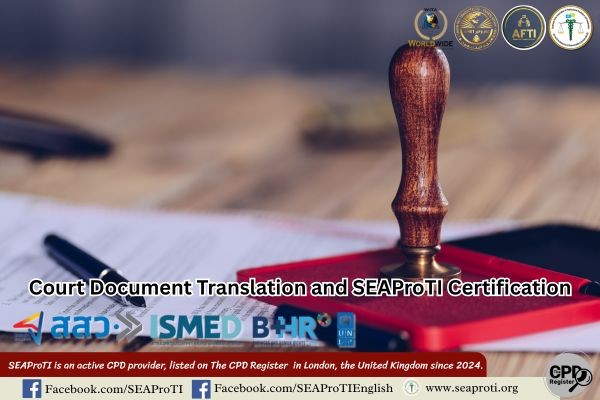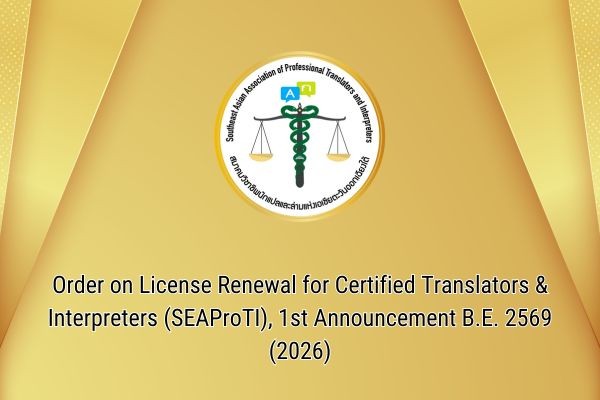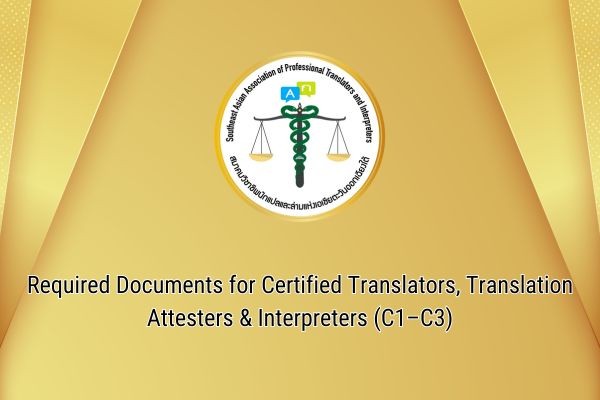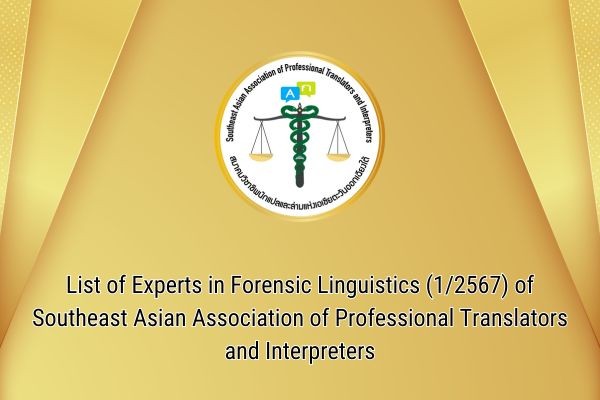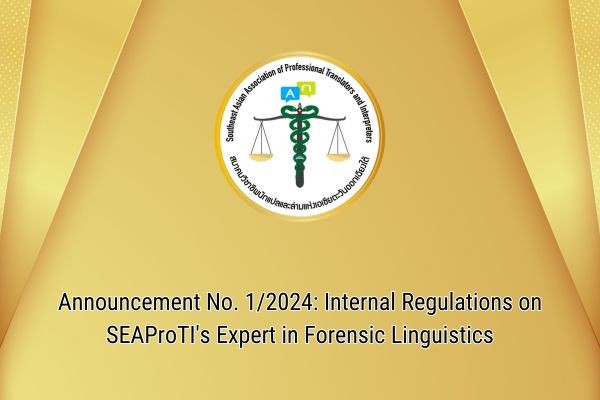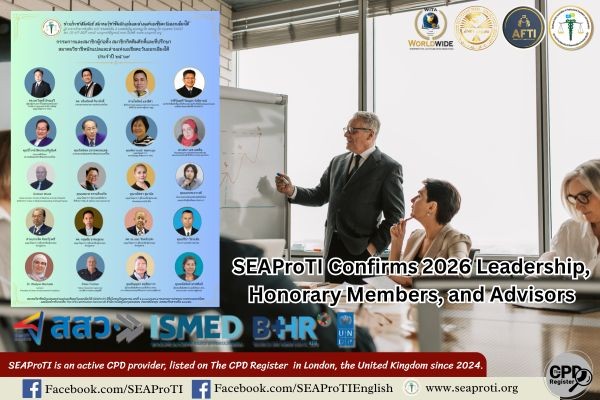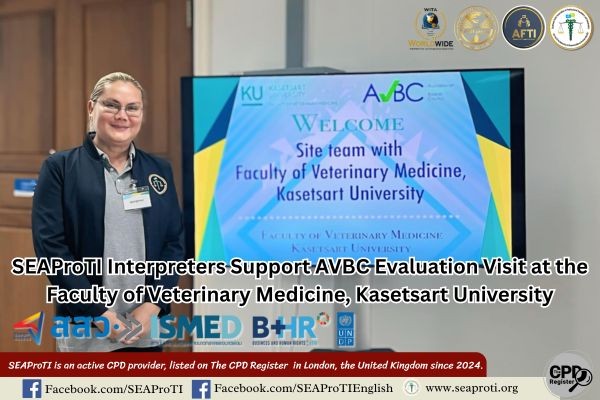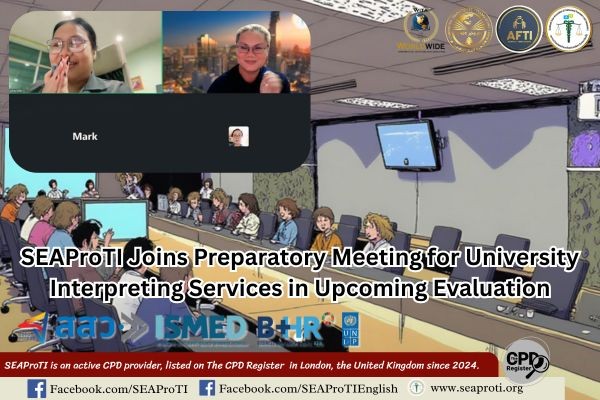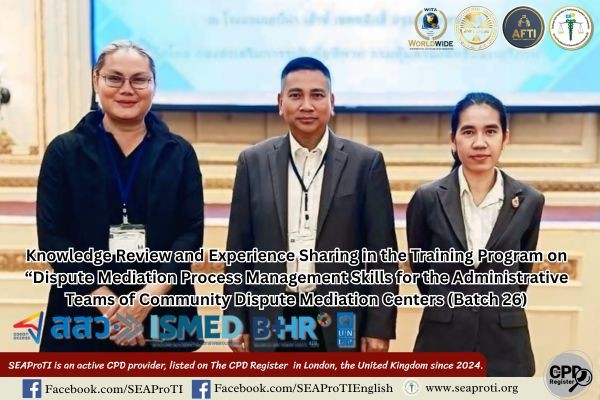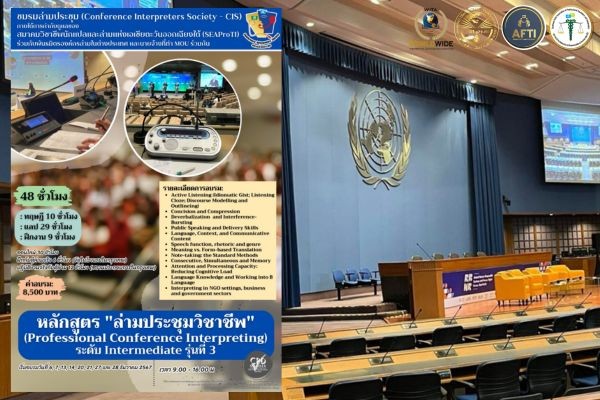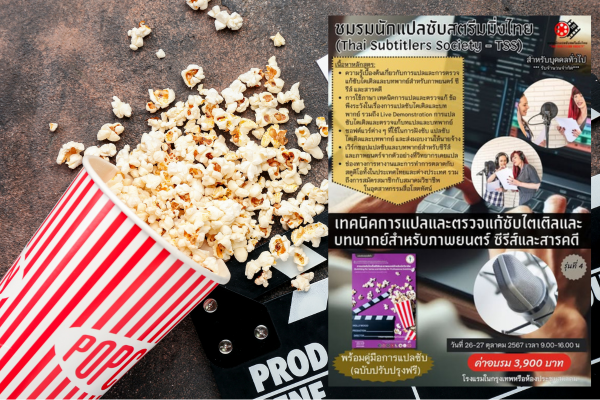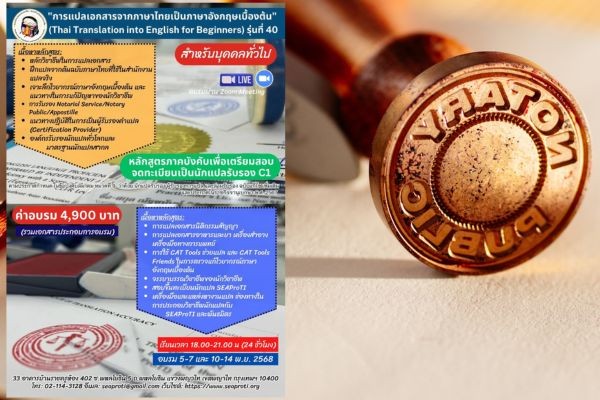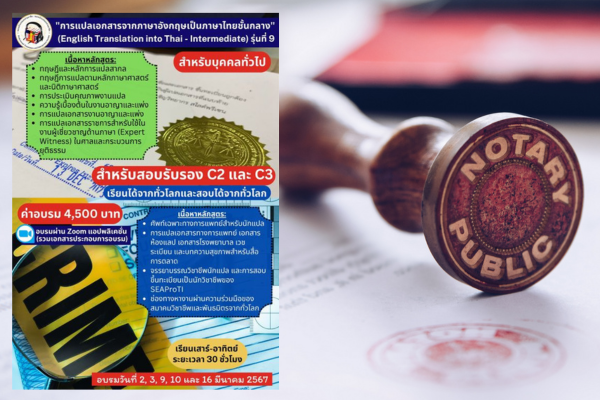Comparative Discourse Analysis between the Khmer and English Versions of the Statement:
Case Study of the Landmine Allegations on the Thailand–Cambodia Border
Author: Wanitcha Sumanat, President of the Southeast Asian Association of Professional Translators and Interpreters (SEAProTI)
14 August 2025, Bangkok – This article conducts a discourse analysis of the Ministry of Foreign Affairs and International Cooperation of the Kingdom of Cambodia’s statement, issued in two versions—Khmer and English (unofficial translation)—denying Thailand’s allegations of newly planted landmines along the border. The analysis compares the structure, linguistic choices, and adaptation strategies for different target audiences. The findings reveal that while the core message remains consistent, the English version expands on international legal principles and adjusts the tone to address the global community. In contrast, the Khmer version places greater emphasis on regional context and agreements, maintaining a distinct critical tone.
Introduction
Diplomatic statements are critical tools in shaping public and stakeholder perceptions in inter-state conflicts (Chilton & Schäffner, 2002). The present case study focuses on Cambodia’s 13 August 2025 statement denying Thailand’s accusations regarding recent landmine incidents along their shared border. With both Khmer and English versions available, a comparative discourse analysis offers insight into linguistic strategies that serve diplomatic and political objectives.
Author’s Intent
A comparison of the two original versions reveals that both share identical overarching objectives:
- Firmly reject Thailand’s accusations that Cambodia planted new landmines.
- Assert Cambodia’s innocence by framing the allegations as baseless and politically motivated.
- Reframe the narrative from defending against accusations to accusing Thailand of violating the ceasefire, treaties, and international law.
- Reinforce Cambodia’s image as a law-abiding and peace-oriented state, referencing international institutions and instruments such as the ICJ, the 2000 MOU, and the Ottawa Convention.
- Influence international opinion by portraying Thailand as the aggressor and a threat to regional peace.
In diplomatic terms, this reflects a defensive–offensive discourse strategy (Becker, 2014), combining rebuttal with counter-framing through legal and moral arguments.
Rhetorical and Discursive Strategies
Khmer Version
- Tone: Employs formal bureaucratic–diplomatic style but with strong critical expressions (e.g., ក្លែងក្លាយ = “fabricated,” គ្មានភស្ដុតាងអាចទុកចិត្តបាន = “devoid of credible evidence”).
- Structure: Begins with denial → contextualizes the border situation and legal documents → highlights Thailand’s violations → promotes Cambodia’s peacekeeper image → concludes with a call for cooperation via ASEAN/ICJ.
- Evidence Framing: Relies heavily on treaties and agreements (Treaties of 1904 and 1907, ICJ 1962 & 2013, MOU 2000) to establish legal credibility.
- Legitimizing Language: Frequent use of terms such as ភាពសន្តិភាព, សុវត្ថិភាព, and សហប្រតិបត្តិការ (“peace,” “security,” “cooperation”) to construct a positive self-image.
English Version
- Tone: Despite being labeled as an unofficial translation, it retains a formal diplomatic tone with equally strong criticism (“categorically rejects,” “fabricated,” “in complete disregard to the terms of the ceasefire”).
- Legalistic Framing: Makes prominent use of international legal terminology (“prohibited threat of force under Article 2(4) of the UN Charter,” “jurisprudence of the ICJ”), directly addressing an international audience.
- International Audience Adaptation: Elaborates on details (e.g., explaining that the 1:200,000 scale maps originate from the 1904 Convention and 1907 Treaty).
- Repetition for Emphasis: Key allegations are repeated—“fabricated,” “devoid of credible evidence,” “demonstrably false”—to reinforce a cognitive frame in the reader’s mind.
Translation and Adaptation
This is not a literal translation but a functional/diplomatic translation (Nida, 1964), preserving the substantive message while adjusting structure and emphasis to meet English-language diplomatic norms.
- Expansion in English: Adds references such as Article 2(4) of the UN Charter, whereas the Khmer version refers more generally to violations of peace and international law.
- Reduction in English: Certain contextual details, such as meeting background or specific individuals, are omitted to maintain focus on the main message.
- Precision for International Platforms: The English version adopts UN/ASEAN-standard legal and diplomatic terminology.
Notable Observations
- Different Target Audiences:
- Khmer: Primarily for domestic audiences, regional stakeholders, and neighboring states.
- English: Targeted directly at the international community, UN member states, ASEAN, and human rights organizations.
- Use of International Forums for Legitimacy:
Both versions cite the ICJ, treaties, and the MOU to project Cambodia as a law-abiding state and to exert diplomatic pressure on Thailand.
- Adversarial Framing:
Thailand is depicted as the aggressor, violating agreements, and issuing provocative rhetoric (“reclaim” and “close” temples).
- Positive Self-Representation:
Although the content of the document constitutes an assertive rebuttal—denying the allegations and counterattacking—it still employs wording that presents itself as reasonable, law-abiding, and peace-seeking. The result of this self-framing is that readers, especially in the international arena, perceive Cambodia as having legitimacy and as the party being wronged rather than the one causing the problem.
Conclusion
The comparative analysis reveals that while both versions employ consistent messaging, the English translation serves a strategic purpose beyond mere linguistic transfer. It adapts the content and tone to maximize persuasive impact on the international stage. This underscores the role of translation as a diplomatic instrument in image management and narrative framing in international disputes.
References
- Becker, H. S. (2014). What about Mozart? What about murder? Reasoning from cases. University of Chicago Press.
- Chilton, P., & Schäffner, C. (2002). Politics as text and talk: Analytic approaches to political discourse. John Benjamins.
- Nida, E. A. (1964). Toward a science of translating: With special reference to principles and procedures involved in Bible translating. Brill.
About Certified Translators, Translation Certification Providers, and Certified Interpreters of SEAProTI
The Southeast Asian Association of Professional Translators and Interpreters (SEAProTI) has published the criteria and qualifications for registering as “Certified Translators,” “Translation Certification Providers,” and “Certified Interpreters” of the Association under Sections 9 and 10 of the Royal Gazette, Secretariat of the Cabinet, Prime Minister’s Office, Kingdom of Thailand, dated 25 July 2024, Vol. 141, Part 66 Ng, p. 100. Full text available at: The Royal Thai Government Gazette
SEAProTI is the first professional association in Thailand and Southeast Asia with a formal certification system for Certified Translators, Translation Certification Providers, and Certified Interpreters.
Head Office: Baan Ratchakhru Building, No. 33, Room 402, Soi Phahonyothin 5, Phahonyothin Road, Phaya Thai Subdistrict, Phaya Thai District, Bangkok 10400, Thailand.
Email: hello@seaproti.com
Tel: (+66) 2-114-3128 (Office hours: Mon–Fri, 9:00–17:00)
การวิเคราะห์วาทกรรมเปรียบเทียบระหว่างแถลงการณ์ภาษาเขมรและภาษาอังกฤษ:
กรณีข้อกล่าวหาเรื่องทุ่นระเบิดชายแดนไทย–กัมพูชา
ผู้แต่ง วณิชชา สุมานัส นายกสมาคมวิชาชีพนักแปลและล่ามแห่งเอเชียตะวันออกเฉียงใต้ (SEAProTI)
14 สิงหาคม 2568, กรุงเทพมหานคร – บทความนี้วิเคราะห์เชิงวาทกรรมของแถลงการณ์กระทรวงการต่างประเทศและความร่วมมือระหว่างประเทศแห่งราชอาณาจักรกัมพูชา ที่ออกเป็นสองฉบับ ได้แก่ ภาษาเขมรและภาษาอังกฤษ (ฉบับแปลไม่เป็นทางการ) เกี่ยวกับการปฏิเสธข้อกล่าวหาของไทยเรื่องการวางทุ่นระเบิดใหม่บริเวณชายแดน โดยมุ่งเปรียบเทียบโครงสร้าง การเลือกใช้ภาษา และการปรับเนื้อหาเพื่อกลุ่มเป้าหมายที่แตกต่างกัน ผลการวิเคราะห์พบว่า แม้สาระสำคัญเหมือนกัน แต่ภาษาอังกฤษมีการขยายความในเชิงกฎหมายระหว่างประเทศและปรับน้ำเสียงเพื่อสื่อสารกับประชาคมโลก ขณะที่ภาษาเขมรเน้นการอ้างอิงบริบทและข้อตกลงระดับภูมิภาคมากขึ้น พร้อมทั้งคงน้ำเสียงวิพากษ์ที่ชัดเจน
บทนำ
แถลงการณ์ทางการทูตเป็นเครื่องมือสำคัญในการกำหนดกรอบความเข้าใจของสาธารณชนและผู้มีส่วนได้เสียในความขัดแย้งระหว่างรัฐ (Chilton & Schäffner, 2002) กรณีศึกษาในบทความนี้คือแถลงการณ์วันที่ 13 สิงหาคม 2025 ของกัมพูชา ที่ปฏิเสธข้อกล่าวหาจากไทยเกี่ยวกับเหตุทุ่นระเบิดชายแดน โดยมีทั้งฉบับภาษาเขมรและภาษาอังกฤษ การวิเคราะห์เชิงวาทกรรมเปรียบเทียบจึงช่วยให้เข้าใจถึงกลยุทธ์การใช้ภาษาเพื่อวัตถุประสงค์ทางการทูตและการเมือง
วัตถุประสงค์ของผู้เขียน
เมื่อเปรียบเทียบทั้งสองภาษาจากทั้งสองต้นฉบับ พบว่า เจตนาหลักเหมือนกัน คือ
- ปฏิเสธข้อกล่าวหาของไทยอย่างแข็งกร้าว ว่ากัมพูชาเป็นฝ่ายวางทุ่นระเบิดใหม่
- ยืนยันความบริสุทธิ์ของกัมพูชา โดยชี้ว่าข้อกล่าวหานั้นไร้หลักฐานและมีวัตถุประสงค์ทางการเมือง
- เปลี่ยนกรอบการสนทนา (reframing) จากการถูกกล่าวหา → ไปสู่การกล่าวโทษไทยว่าละเมิดข้อตกลงหยุดยิง สนธิสัญญา และกฎหมายระหว่างประเทศ
- ตอกย้ำความเป็นรัฐที่เคารพกฎหมายและสันติวิธี เพื่อสร้างภาพลักษณ์ในสายตาสากล และอ้างอิงองค์กร/เอกสารนานาชาติ เช่น ICJ, MOU 2000, Ottawa Convention
- ชี้นำสังคมระหว่างประเทศ ว่าไทยเป็นฝ่ายรุกรานและเป็นภัยต่อสันติภาพในภูมิภาค
ในเชิงเจตนาทางการทูต นี่คือ defensive + offensive discourse คือป้องกันข้อหา + รุกกลับด้วยการตีกรอบเรื่องในเชิงกฎหมายและศีลธรรมวัตถุประสงค์ดังกล่าวสะท้อนกลยุทธ์ “defensive-offensive” (Becker, 2014) คือการป้องกันข้อหาและโจมตีกลับผ่านการอ้างอิงหลักกฎหมายและศีลธรรมสากล
กลยุทธ์การใช้ภาษา (Rhetorical & Discursive Strategies)
ฉบับภาษาเขมร
- น้ำเสียง (Tone):
- ใช้โครงสร้างราชการ-การทูตแบบเป็นทางการ (formal bureaucratic style) แต่มีถ้อยคำที่แรงเชิงตำหนิ (“ក្លែងក្លាយ” = fabricated, “គ្មានភស្ដុតាងអាចទុកចិត្តបាន” = devoid of credible evidence)
- การเรียงประเด็น (Structure):
- เริ่มด้วยการปฏิเสธข้อกล่าวหา → อธิบายบริบทเขตแดนและกฎหมาย → ชี้ให้เห็นการละเมิดของไทย → เสนอภาพลักษณ์กัมพูชาในฐานะผู้รักษาสันติ → ปิดท้ายด้วยการเรียกร้องความร่วมมือและใช้เวทีอาเซียน/ICJ
- การอ้างอิงหลักฐาน (Evidence framing):
- เน้นเอกสารและข้อตกลงที่ลงนามแล้ว (สนธิสัญญา 1904, 1907, ICJ 1962 & 2013, MOU 2000) เพื่อสร้างน้ำหนักเชิงกฎหมาย
- การใช้ถ้อยคำสร้างความชอบธรรม:
- ใช้คำอย่าง “ភាពសន្តិភាព”, “សុវត្ថិភាព”, “សហប្រតិបត្តិការ” (peace, security, cooperation) เพื่อสร้างภาพบวกของกัมพูชาในสายตาผู้อ่าน
ฉบับภาษาอังกฤษ
- Tone:
- แม้จะเป็น unofficial translation แต่ก็ยังคงน้ำเสียงการทูตอย่างเป็นทางการ พร้อมแฝงน้ำเสียงโจมตีที่รุนแรงพอสมควร (“categorically rejects”, “fabricated”, “in complete disregard to the terms of the ceasefire”)
- Legalistic framing:
- ใช้โครงสร้างและศัพท์กฎหมายระหว่างประเทศชัดเจน (“prohibited threat of force under Article 2(4) of the UN Charter”, “jurisprudence of the ICJ”) ซึ่งอาจสื่อถึงผู้อ่านสากลโดยตรง
- International audience adaptation:
- ภาษาอังกฤษใช้วิธีขยายความ (elaboration) ให้ชัดต่อผู้อ่านต่างชาติ เช่น อธิบายว่าแผนที่ 1:200,000 scale maps มาจาก 1904 Convention and 1907 Treaty
- Repetition for emphasis:
- เน้นซ้ำว่าข้อกล่าวหาของไทย “fabricated”, “devoid of credible evidence”, “demonstrably false” เพื่อสร้างกรอบคิดซ้ำๆ ในใจผู้อ่าน
การแปลและการปรับเนื้อหา (Translation & Adaptation)
- ไม่ใช่การแปลตรงตัว (not literal) แต่เป็น functional / diplomatic translation ที่คงสาระสำคัญ แต่ปรับโครงสร้างและน้ำหนักบางจุดให้เข้ากับมาตรฐานแถลงการณ์ทางการทูตในภาษาอังกฤษ
- บางจุดในภาษาอังกฤษมีการขยายข้อมูล เช่น การอ้าง Article 2(4) ของ UN Charter ซึ่งต้นฉบับภาษาเขมรระบุเพียงว่าเป็นการละเมิดหลักการสันติภาพและกฎหมายระหว่างประเทศ
- บางจุดมีการลดทอน เช่น ภาษาเขมรอาจมีรายละเอียดบริบทการประชุมหรือชื่อบุคคลที่ถูกละไว้ในภาษาอังกฤษ เพื่อให้โฟกัสที่สารหลัก
- น้ำเสียงภาษาอังกฤษชัดเจนสำหรับเวทีนานาชาติ — มีการใช้ศัพท์เทคนิคทางกฎหมายและการทูตที่ตรงกับมาตรฐาน UN/ASEAN
ข้อสังเกตที่น่าสนใจ
- Target Audience ต่างกัน
- ภาษาเขมร: มุ่งสื่อสารต่อสาธารณชนและหน่วยงานภายในประเทศ + ประเทศเพื่อนบ้าน
- ภาษาอังกฤษ: มุ่งตรงไปยังเวทีนานาชาติ, รัฐสมาชิก UN, ASEAN, และองค์กรสิทธิมนุษยชน
- การใช้เวทีนานาชาติเป็นเครื่องมือสร้างความชอบธรรม
- ทั้งสองภาษาอ้างอิง ICJ, สนธิสัญญา, MOU เพื่อให้กัมพูชาดูเป็นฝ่ายเคารพกฎหมาย และสร้างแรงกดดันต่อไทยในทางการทูต
- การโจมตีคู่กรณีผ่าน framing
- ไทยถูกวางภาพเป็นฝ่ายรุกราน, ละเมิดข้อตกลง, ใช้วาทกรรมข่มขู่ (เช่น “reclaim” (ยึดคืน) และ “close” ปิดวัด) เพื่อให้ผู้อ่านรู้สึกว่าไทยเป็นภัยคุกคาม
- การใช้ภาษาสร้างภาพลักษณ์ตนเอง
- แม้เนื้อหาในเอกสารจะเป็นการตอบโต้เชิงรุก (assertive rebuttal) คือการปฏิเสธข้อกล่าวหาและโจมตีกลับ แต่ก็ยังใช้ถ้อยคำที่ทำให้ภาพลักษณ์ของตนดูเป็นผู้มีเหตุผล ทำตามกฎหมาย และต้องการสันติ ผลลัพธ์ของการวางภาพ ทำให้ผู้อ่าน โดยเฉพาะในเวทีนานาชาติ รู้สึกว่ากัมพูชามีความชอบธรรม (legitimacy) และเป็นฝ่ายที่ถูกกระทำมากกว่าฝ่ายที่สร้างปัญหา
สรุป
การเปรียบเทียบแถลงการณ์ทั้งสองฉบับชี้ให้เห็นว่ากัมพูชาใช้กลยุทธ์การสื่อสารที่สอดคล้องกันในสารหลัก แต่ปรับเนื้อหาและน้ำเสียงตามกลุ่มเป้าหมาย การแปลภาษาอังกฤษจึงไม่เพียงถ่ายทอดความหมาย แต่ยังเป็นการปรับเชิงกลยุทธ์เพื่อเพิ่มพลังโน้มน้าวต่อประชาคมโลก ทั้งนี้ การศึกษาลักษณะเช่นนี้ช่วยให้เข้าใจถึงบทบาทของการแปลในฐานะเครื่องมือทางการทูตและการสร้างภาพลักษณ์ระหว่างประเทศ
เอกสารอ้างอิง
- Becker, H. S. (2014). What about Mozart? What about murder? Reasoning from cases. University of Chicago Press.
- Chilton, P., & Schäffner, C. (2002). Politics as text and talk: Analytic approaches to political discourse. John Benjamins.
- Nida, E. A. (1964). Toward a science of translating: With special reference to principles and procedures involved in Bible translating. Brill.
เกี่ยวกับนักแปลรับรอง ผู้รับรองการแปล และล่ามรับรองของสมาคมวิชาชีพนักแปลและล่ามแห่งเอเชียตะวันออกเฉียงใต้
สมาคมวิชาชีพนักแปลและล่ามแห่งเอเชียตะวันออกเฉียงใต้ (SEAProTI) ได้ประกาศหลักเกณฑ์และคุณสมบัติผู้ที่ขึ้นทะเบียนเป็น “นักแปลรับรอง (Certified Translators) และผู้รับรองการแปล (Translation Certification Providers) และล่ามรับรอง (Certified Interpreters)” ของสมาคม หมวดที่ 9 และหมวดที่ 10 ในราชกิจจานุเบกษา ของสำนักเลขาธิการคณะรัฐมนตรี ในสำนักนายกรัฐมนตรี แห่งราชอาณาจักรไทย ลงวันที่ 25 ก.ค. 2567 เล่มที่ 141 ตอนที่ 66 ง หน้า 100 อ่านฉบับเต็มได้ที่: นักแปลรับรอง ผู้รับรองการแปล และล่ามรับรอง
*สมาคมวิชาชีพนักแปลและล่ามแห่งเอเชียตะวันออกเฉียงใต้ เป็นสมาคมวิชาชีพแห่งแรกในประเทศไทยและภูมิภาคเอเชียตะวันออกเฉียงใต้ที่มีระบบรับรองนักแปลรับรอง ผู้รับรองการแปล และล่ามรับรอง
สำนักงานใหญ่: อาคารบ้านราชครู เลขที่ 33 ห้อง 402 ซอยพหลโยธิน 5 ถนนพหลโยธิน แขวงพญาไท เขตพญาไท กรุงเทพมหานคร 10400 อีเมล: hello@seaproti.com โทรศัพท์: (+66) 2-114-3128 (เวลาทำการ: วันจันทร์–วันศุกร์ เวลา 9.00–17.00 น.)
